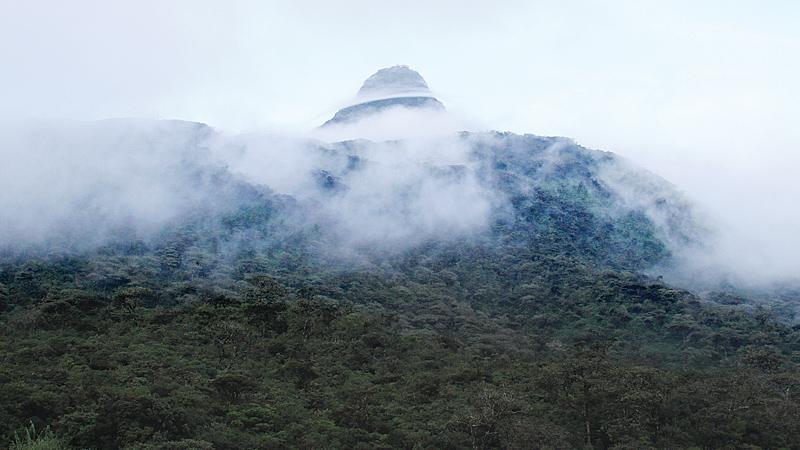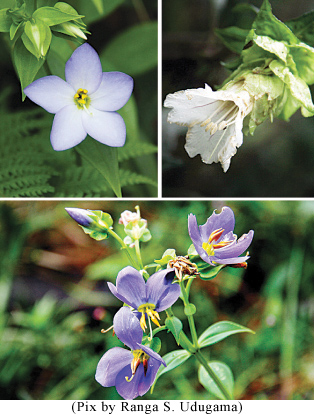
There is perhaps no other peak so often and regularly ascended by humans, as the Sri Pada. This year as the Sri Pada season begins on December 13, with the Unduvap poya, for some it is an annual pilgrimage that must be undertaken, while to many it is a trip that one must complete at least once in a lifetime. Every year, starting from Unduvap poya till Vesak, pilgrims of all faiths undertake the gruelling trek to its summit, located 7,353 feet above sea level while others make attempts to scale the mountain during its off season when the weather and the climb can be most treacherous.
However, due to various beliefs and customs, the journey, whether during the season or not, is one steeped in tradition, history and legends, with its importance going far beyond. The journey to Sri Pada brings together those of all religions and beliefs in their arduous trek to the top which perhaps silently teaches us that in life too one must undertake life’s journey while living in peace, harmony and brotherhood, with all we chance upon.
 A traveller attempting to scale Sri Pada can choose between six routes. Hatton - Nallathanni, the steepest but shortest is considered to be the most popular route among pilgrims, while the Ratnapura - Palabaddala and the Kuruwita - Erathna routes are also those regularly used by travellers. Murrayawatta, Mukkuwatta and Malimbada routes today are however used mainly by adventure travellers and less by pilgrims, due to the difficulties and dangers involved.
A traveller attempting to scale Sri Pada can choose between six routes. Hatton - Nallathanni, the steepest but shortest is considered to be the most popular route among pilgrims, while the Ratnapura - Palabaddala and the Kuruwita - Erathna routes are also those regularly used by travellers. Murrayawatta, Mukkuwatta and Malimbada routes today are however used mainly by adventure travellers and less by pilgrims, due to the difficulties and dangers involved.
The ascent to Sri Pada whichever route you choose, is by foot through the forested mountain side with the more popular routes having thousands of cemented steps built into it. During the season the path is illuminated with electric light and rest stops and wayside shops selling refreshments and supplies.
However, the pilgrimage to Sri Pada due to its customs is unlike any other experienced even within Sri Lanka. A journey with its own lingo, it is common to hear words unique to the trip, such as, Nadey (Group), Nadey Gura (Head of the Group) , Kodukarayo (Novice), Karunawa (Climb). A common advice given to a novice is, they should refrain from uttering anything deemed disrespectful to God Sumana Saman, the deity believed to dwell in the area. It is also considered taboo to talk about the amount of time the journey may take as elders believe it will cause something untoward, preventing their ascent. Singing of traditional folk songs is also common, to keep up the spirits of the pilgrims fatigued by the long trek.
Before the ascent all pilgrims seek blessings from clergy and pray for a safe journey. While pilgrims are expected to bathe in the Seetha Gangula before ascent, interestingly, the leader of the group prepares a coin cleaned by rubbing it on a lime and wrapped in a white cloth, as an offering to God Sumana Saman which is tied to the right hand of novice climbers, called Kodukarayo. It is considered to be a sign that the safety of novices is then at the hands of the God who is expected to protect them till their return. Thereafter, the novice will leave the offering at the God’s shrine near the river where he bathed.
In the various routes taken, there exist numerous stops with similarly intriguing stories. The Palabaddala route, or the ´Raja Mawatha’ (Way of the Royals) so called because it was often used by King Nissankamalla is perhaps the most interesting.
Along this route, the first interesting stop that one comes across is ´Lihini Hela´ (Lihini Dell). According to legend and the historical text, Samanala Hella, a woman named Lihini committed suicide by leaping off this dell. Today, pilgrims make a brief stop to call out to her in remembrance. As people shout ¨Lihin Akke¨”(Sister Lihini) everyone can hear an unmistakable ¨O… O… O...¨ (Yes) in retort as the noise echoes through the mountains, with some cheeky youngsters even asking questions such as, ¨Lihini Akke, Aiya Gedarada?¨ (Sister Lihini, is your husband home?) to which they receive a reply of yes, as they roar with laughter.
As pilgrims continue on to the Katukitula bend and walk further, they get the rare opportunity to witness the birth of a river. If not for the signpost alerting travellers to the beginning of the Kalu River, it is easily mistaken for a mere stream.
The next important place is Gettampana, where legend claims Lord Buddha stopped to mend his robes which had been torn, getting tangled in the shrubbery, on his visit to Sri Pada. Therefore, as a tradition pilgrims continue to stop here to tangle needle and thread along this stretch in memory of this.
Haramitipana which follows, is said to be the place where a fatigued Buddha picked up a stick and continued to climb the Dharmaraja Rock. In the past it is said, pilgrims offered their walking sticks at this point before continuing to climb the last stretch of Sri Pada.
At the peak, pilgrims toll the heavy bell, once for each time they have visited the mountain. No trek is complete without witnessing the sunrise which casts the shadow of the mountain on the surrounding plain. This is an experience which makes the gruelling hike up the mountain and its thousands of steps rewarding, along with their faith beckoning them to scale the holy peak, time and time again.
Plastic and polythene
 The Buddha is a manifestation of complete compassion and is seen as the compassionate protector of all beings. He taught that, those who wish to follow his Path should practise loving-kindness, and not harm the life of any beings - not only to protect mankind, but also to protect animals and vegetation.
The Buddha is a manifestation of complete compassion and is seen as the compassionate protector of all beings. He taught that, those who wish to follow his Path should practise loving-kindness, and not harm the life of any beings - not only to protect mankind, but also to protect animals and vegetation.
However, despite this being the word of Lord Buddha many pilgrims continue to litter the path up to Sri Pada with plastic and polythene, a problem the authorities have to face every season. With many volunteer groups, and the Sri Lanka Army attempting to clean the area, non-degradable garbage can be found even during the off season, with the natural beauty, the environment and clean water sources being destroyed by the travellers, while a large amount of man hours are wasted in the clean up.
This year plastic and polythene have been banned by the authorities, and pilgrims should be mindful about their behaviour to protect the Sri Pada reserve.
